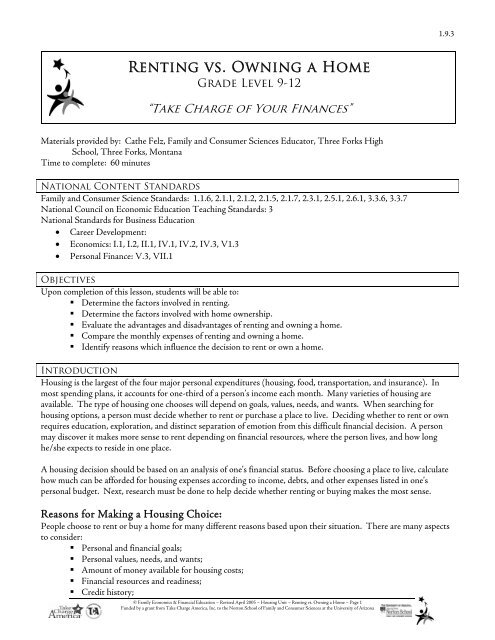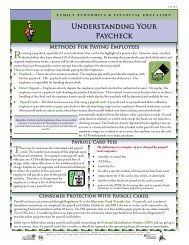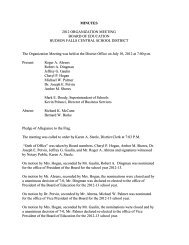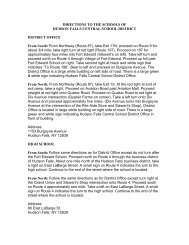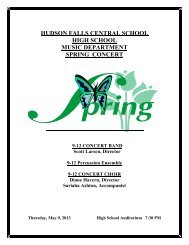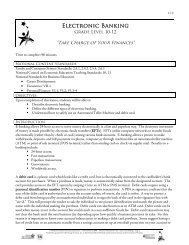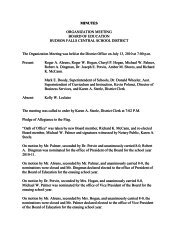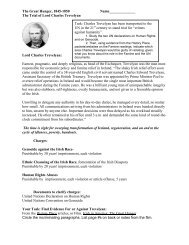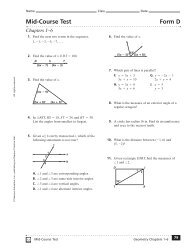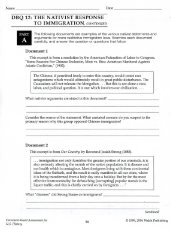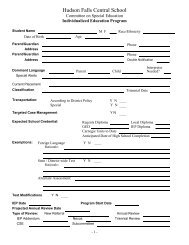Renting vs. Owning a Home
Renting vs. Owning a Home
Renting vs. Owning a Home
You also want an ePaper? Increase the reach of your titles
YUMPU automatically turns print PDFs into web optimized ePapers that Google loves.
1.9.3<br />
<strong>Renting</strong> <strong>vs</strong>. <strong>Owning</strong> a <strong>Home</strong><br />
Grade Level 9-12<br />
“Take Charge of Your Finances”<br />
Materials provided by: Cathe Felz, Family and Consumer Sciences Educator, Three Forks High<br />
School, Three Forks, Montana<br />
Time to complete: 60 minutes<br />
National Content Standards<br />
Family and Consumer Science Standards: 1.1.6, 2.1.1, 2.1.2, 2.1.5, 2.1.7, 2.3.1, 2.5.1, 2.6.1, 3.3.6, 3.3.7<br />
National Council on Economic Education Teaching Standards: 3<br />
National Standards for Business Education<br />
• Career Development:<br />
• Economics: I.1, I.2, II.1, IV.1, IV.2, IV.3, V1.3<br />
• Personal Finance: V.3, VII.1<br />
Objectives<br />
Upon completion of this lesson, students will be able to:<br />
• Determine the factors involved in renting.<br />
• Determine the factors involved with home ownership.<br />
• Evaluate the advantages and disadvantages of renting and owning a home.<br />
• Compare the monthly expenses of renting and owning a home.<br />
• Identify reasons which influence the decision to rent or own a home.<br />
Introduction<br />
Housing is the largest of the four major personal expenditures (housing, food, transportation, and insurance). In<br />
most spending plans, it accounts for one-third of a person’s income each month. Many varieties of housing are<br />
available. The type of housing one chooses will depend on goals, values, needs, and wants. When searching for<br />
housing options, a person must decide whether to rent or purchase a place to live. Deciding whether to rent or own<br />
requires education, exploration, and distinct separation of emotion from this difficult financial decision. A person<br />
may discover it makes more sense to rent depending on financial resources, where the person lives, and how long<br />
he/she expects to reside in one place.<br />
A housing decision should be based on an analysis of one’s financial status. Before choosing a place to live, calculate<br />
how much can be afforded for housing expenses according to income, debts, and other expenses listed in one’s<br />
personal budget. Next, research must be done to help decide whether renting or buying makes the most sense.<br />
Reasons for Making a Housing Choice:<br />
People choose to rent or buy a home for many different reasons based upon their situation. There are many aspects<br />
to consider:<br />
• Personal and financial goals;<br />
• Personal values, needs, and wants;<br />
• Amount of money available for housing costs;<br />
• Financial resources and readiness;<br />
• Credit history;<br />
© Family Economics & Financial Education – Revised April 2005 – Housing Unit – <strong>Renting</strong> <strong>vs</strong>. <strong>Owning</strong> a <strong>Home</strong> – Page 1<br />
Funded by a grant from Take Charge America, Inc. to the Norton School of Family and Consumer Sciences at the University of Arizona
1.9.3<br />
• Real estate prices;<br />
• Location preference;<br />
• Expected length of stay in a particular place.<br />
Comparison of Expenses:<br />
<strong>Renting</strong><br />
• Monthly rent;<br />
• Security deposit;<br />
• Utilities – electricity, water, garbage,<br />
etc.;<br />
• Renter’s insurance.<br />
<strong>Owning</strong><br />
• Monthly mortgage payments<br />
• Down payment (one time cost);<br />
• Closing costs (one time cost);<br />
• Utilities – electricity, water, garbage, etc.<br />
• <strong>Home</strong>owner’s insurance<br />
• Real estate property taxes<br />
• Maintenance<br />
<strong>Renting</strong>:<br />
Rent is the cost of using someone else’s property. Examples of property choices include apartments, condos, houses,<br />
mobile homes, etc. A tenant, or renter, is a person who rents the property. Tenants are generally people who either<br />
cannot afford home ownership or have chosen not to purchase a home. The owner of the rental property is the<br />
landlord. The landlord may act as a property manager or hire an agent to perform the management duties. A<br />
property manager’s duties may include collecting rent and deposits, paying utility bills, performing repairs and<br />
maintenance, watching over the property, responding to tenant complaints, assigning new tenants, etc. The property<br />
manager may charge a fee to the landlord to perform the management tasks. Rent is usually due on the first day of<br />
each month to the landlord or property manager.<br />
When moving into a new place, people are usually required to pay a security deposit and sign a lease. A security<br />
deposit is an advance payment to cover anything beyond normal wear and tear on the unit. This deposit may be<br />
returned to the tenant when the unit is left in good condition. A lease is a legal contract between the tenant and the<br />
landlord specifying the responsibilities and rights of both parties. Lease agreements identify the rent amount,<br />
security deposit amount and details on items such as: payment for utility bills, late payment penalties, length of lease,<br />
and eviction terms.<br />
Advantages of renting include:<br />
• Low move-in costs;<br />
• Fixed monthly expenses;<br />
• Easy to move;<br />
• Location choices (may be close to work or school);<br />
• Less maintenance and repair work;<br />
• Fewer responsibilities;<br />
• May offer extra amenities such as a tennis court or pool;<br />
• Less expensive than home ownership;<br />
• May be able to save for other wants or needs if renting a less expensive apartment;<br />
• Other expenses may be included in rent payment including electricity, water, sewer, and/or garbage.<br />
Disadvantages of renting include:<br />
• Subject to terms of a lease;<br />
• Rent may change with little notice;<br />
• Less privacy and transient neighbors;<br />
© Family Economics & Financial Education – Revised April 2005 – Housing Unit – <strong>Renting</strong> <strong>vs</strong>. <strong>Owning</strong> a <strong>Home</strong> – Page 2<br />
Funded by a grant from Take Charge America, Inc. to the Norton School of Family and Consumer Sciences at the University of Arizona
1.9.3<br />
• Restrictions on noise level and/or pets;<br />
• Fewer opportunities to upgrade apartment (i.e. new carpet, paint, or wallpaper);<br />
• When leaving a property, no equity is returned as it would be if selling a home;<br />
• No tax deductions;<br />
• May lose rental if the property is sold.<br />
<strong>Owning</strong>:<br />
<strong>Home</strong> ownership means the buyer has purchased a housing unit as property. <strong>Home</strong> ownership is a goal of many<br />
Americans and is something many individuals consider to be an indication of the “American Dream.” <strong>Home</strong><br />
ownership shelters hard-earned dollars from taxation, provides a hedge against inflation, builds wealth, and helps to<br />
provide security in retirement.<br />
Approximately two out of three American families own the homes in which they live. Some 63 million U.S.<br />
households own their homes. <strong>Home</strong> ownership can be a source of great pride to many people. Many renters would<br />
prefer to own, but cannot afford the necessary down payment or the costs of ownership. Buying a home is a<br />
significant investment of wealth in the U.S. It is a major financial decision which is a mystery to many first time<br />
home buyers. Americans have almost $9.1 trillion invested in single-family homes, according to estimates by the<br />
Federal National Mortgage Association. Their equity, the value of what they own outright after mortgage debt,<br />
amounts to about $5.4 trillion dollars (above statistics from The Wall Street Journal Lifetime Guide to Money, C.<br />
Frederic Wiegold).<br />
The decision to purchase a home should not be taken lightly. As millions of home buyers learned to their dismay in<br />
the late 1980s and early 1990s, it can be a money-losing proposition. Though national home-price averages<br />
remained stable, the cost of housing in some areas skyrocketed as a result of sudden economic prosperity only to<br />
plummet a few years later. The fluctuation in the cost of housing and the resale value of homes made it difficult for<br />
many sellers to recoup their initial investment. If investors were unable to keep their investment, they lost large sums<br />
of money. Investors who kept their property until the market recovered were able to resell at a profit. With so much<br />
at stake, it is essential to perform research before buying a home. If ownership is not feasible at this time, sound<br />
financial planning and savings can assist a person in planning for the benefits of home ownership later in life.<br />
To purchase real estate, many people apply for a mortgage. A mortgage is a home loan in which the real estate is the<br />
collateral. Collateral is an item promised to the lender if the borrower does not pay back the loan. Collateral is<br />
usually the item that was purchased with the borrowed funds. 90% of buyers use a mortgage to purchase a home.<br />
The three main components to a mortgage are the amount borrowed, the interest rate, and the length of the loan.<br />
The amount of money borrowed for the loan depends on the size of the down payment and the price of the home.<br />
The recommended purchase price an individual should pay for a home is 2 ½ times their annual household income.<br />
A down payment is the amount of money paid on the home at the time of purchase. The larger the down payment,<br />
the smaller the amount borrowed which lowers the monthly payment. A down payment is typically 10 – 20% of the<br />
purchase price of the home (above statistics from Personal Finance, Elizabeth B. Goldsmith, 2001). The interest<br />
rate of the loan will fluctuate according to state of the U.S. economy. The typical length of a loan is thirty years, but<br />
this may vary.<br />
Advantages of home ownership include:<br />
• Build equity which can be borrowed against if necessary;<br />
• Pride of ownership;<br />
• Feel more comfortable and have more privacy;<br />
• Stable mortgage payments;<br />
• More room and storage;<br />
• Improvement of buyer’s credit rating;<br />
© Family Economics & Financial Education – Revised April 2005 – Housing Unit – <strong>Renting</strong> <strong>vs</strong>. <strong>Owning</strong> a <strong>Home</strong> – Page 3<br />
Funded by a grant from Take Charge America, Inc. to the Norton School of Family and Consumer Sciences at the University of Arizona
1.9.3<br />
• Income tax deductions for property taxes and mortgage interest;<br />
• Property may increase in value;<br />
• Free to make home improvements and have pets (items typically not allowed in rentals).<br />
Disadvantages of home ownership:<br />
• Large down payment;<br />
• Move-in costs;<br />
• Insurance costs;<br />
• Possible for property to decrease in value;<br />
• Time, money, and energy commitment;<br />
• Repair and maintenance costs;<br />
• Property taxes can raise substantially;<br />
• Money is tied up in the home;<br />
• May take several months to sell a home if trying to relocate.<br />
In this lesson, students learn about renting versus owning a home including the factors involved, advantages,<br />
disadvantages, expenses, and reasons to choose a rental or home ownership. Students compare two different rental<br />
units and two different homes listed for sale.<br />
Body<br />
1. Ask the students to raise their hand if they plan on buying a house someday.<br />
a. Then ask them to think about reasons why this is a goal.<br />
2. Tell the students they will be completing the following activity on renting versus owning a home.<br />
a. Divide the students into groups of 3-4.<br />
b. Give each group a poster board with markers.<br />
c. Each group should divide the poster board in half by drawing a line down the middle. Label the left<br />
side ‘rent’ and the right side ‘own.’<br />
d. They will have five minutes to write down reasons why people would rent a home on the left side of<br />
the poster board.<br />
e. Then they will have five minutes to write down reasons why people would own a home on the right<br />
side of the poster board.<br />
f. Each group needs to appoint one person to read the reasons to the class after the brainstorming.<br />
3. After the time is up, have the students go back to their seats.<br />
4. Have the appointed person cut poster board in half.<br />
a. Tape the reasons to rent housing on one wall.<br />
b. Tape the reasons to own a home to another wall.<br />
5. Have the appointed person read the lists to the class. Discuss the answers given by the students.<br />
6. Hand out the <strong>Renting</strong> <strong>vs</strong>. <strong>Owning</strong> a <strong>Home</strong> worksheet 1.9.3.A1 for students to complete during the<br />
PowerPoint presentation.<br />
7. Give the <strong>Renting</strong> <strong>vs</strong>. <strong>Owning</strong> a <strong>Home</strong> PowerPoint presentation 1.9.3.G1 to understand the differences<br />
between renting and owning a home.<br />
a. Slides 1- 3: Introduction<br />
b. Slide 4: Reasons for making a housing choice<br />
c. Slides 5-6: Comparison of expenses<br />
d. Slides 7-11: <strong>Renting</strong><br />
e. Slides 12-15: <strong>Owning</strong><br />
f. Slide 16: Conclusion<br />
© Family Economics & Financial Education – Revised April 2005 – Housing Unit – <strong>Renting</strong> <strong>vs</strong>. <strong>Owning</strong> a <strong>Home</strong> – Page 4<br />
Funded by a grant from Take Charge America, Inc. to the Norton School of Family and Consumer Sciences at the University of Arizona
1.9.3<br />
Conclusion<br />
After the presentation, ask the students to list any other reasons why someone would choose to rent or own a home<br />
and record the answers on the board.<br />
Assessment<br />
Students complete the Housing Comparison worksheet 1.9.3.A2.<br />
• Using the classified ads section of the newspaper or the internet, students must find two rental units and<br />
two homes listed for purchase to compare and attach the ads to the worksheet.<br />
• This worksheet may be completed in class or as homework.<br />
Materials<br />
<strong>Renting</strong> <strong>vs</strong>. <strong>Owning</strong> a <strong>Home</strong> worksheet – 1.9.3.A1<br />
Housing Comparison worksheet – 1.9.3.A2<br />
<strong>Renting</strong> <strong>vs</strong>. <strong>Owning</strong> a <strong>Home</strong> information sheet – 1.9.3.F1<br />
<strong>Renting</strong> <strong>vs</strong>. <strong>Owning</strong> a <strong>Home</strong> PowerPoint presentation – 1.9.3.G1<br />
Poster board, markers, scissors, tape<br />
Newspapers or internet<br />
How to Locate a Living Space Lesson Plan 1.9.2<br />
© Family Economics & Financial Education – Revised April 2005 – Housing Unit – <strong>Renting</strong> <strong>vs</strong>. <strong>Owning</strong> a <strong>Home</strong> – Page 5<br />
Funded by a grant from Take Charge America, Inc. to the Norton School of Family and Consumer Sciences at the University of Arizona
1.9.3.A1<br />
Worksheet<br />
<strong>Renting</strong> <strong>vs</strong>. <strong>Owning</strong> a <strong>Home</strong><br />
Name_____________<br />
Total Points Earned<br />
24 Total Points Possible<br />
Percentage<br />
Date_____________<br />
Directions: Answer the following questions based upon the renting <strong>vs</strong>. owning information.<br />
1. Housing is approximately of a person’s income. (1 point)<br />
2. What is renting (1 point)<br />
3. Who is the landlord (1 point)<br />
4. When moving into a rental, what two things are people usually required to do (2 points)<br />
5. What are three costs of renting (3 points)<br />
6. Complete the chart below by listing three advantages and disadvantages of renting. (6 points)<br />
Advantages of <strong>Renting</strong><br />
1. 1.<br />
Disadvantages of <strong>Renting</strong><br />
2. 2.<br />
3. 3.<br />
7. How much is usually paid at the time of a home purchase (1 point)<br />
8. What are three costs of ownership (3 points)<br />
9. Complete the chart below by listing three advantages and disadvantages of ownership. (6 points)<br />
Advantages of Ownership<br />
Disadvantages of Ownership<br />
1. 1.<br />
2. 2.<br />
3. 3.<br />
© Family Economics & Financial Education – Revised April 2005 – Housing Unit – <strong>Renting</strong> <strong>vs</strong>. <strong>Owning</strong> a <strong>Home</strong> – Page 6<br />
Funded by a grant from Take Charge America, Inc. to the Norton School of Family and Consumer Sciences at the University of Arizona
1.9.3.A2<br />
Worksheet<br />
Housing Comparison<br />
Name_____________<br />
Total Points Earned<br />
37 Total Points Possible<br />
Percentage<br />
Date_____________<br />
Directions: Read the scenarios for a renter and a potential home buyer. Find advertisements for two rental units<br />
and two homes for sale and attach copies. Compare the two ads to each other by completing the charts and<br />
answering the questions. A minimum of seven criteria must be completed for each advertisement.<br />
Rental Units<br />
Scenario #1: Carrie, Martha, and Ally are looking for a place to rent for the school year starting in two months.<br />
Martha has a cat and they would prefer three bedrooms and two bathrooms. (14 points)<br />
Date published:<br />
Newspaper or Web site:<br />
Define any abbreviations<br />
included in the ad:<br />
Advertisement #1 Advertisement #2<br />
Monthly rent:<br />
Upfront costs:<br />
Expenses covered by the rent:<br />
Expenses not covered by the rent:<br />
Advantages of the property<br />
include:<br />
Disadvantages of the property<br />
include:<br />
Restrictions on the property:<br />
(pet owners, smokers, etc.)<br />
1. Choose one of the two apartments which best fits the needs of the scenario. State three reasons why.<br />
(4 points)<br />
© Family Economics & Financial Education – Revised April 2005 – Housing Unit – <strong>Renting</strong> <strong>vs</strong>. <strong>Owning</strong> a <strong>Home</strong> – Page 7<br />
Funded by a grant from Take Charge America, Inc. to the Norton School of Family and Consumer Sciences at the University of Arizona
1.9.3.A2<br />
Worksheet<br />
<strong>Home</strong>s for Sale<br />
Scenario #2: Bob and Mary are newlyweds. They work full time, have no children, and seem to have many of<br />
their friends and family coming to visit often. They would like to buy a home. Bob’s annual income is $35,000<br />
and Mary’s annual income is $19,000. (14 points)<br />
Date published:<br />
Newspaper or Web site:<br />
Price of the property:<br />
Calculate the estimated down<br />
payment:<br />
Location of the property:<br />
Advertisement #1 Advertisement #2<br />
Define any abbreviations<br />
included in the ad:<br />
Advantages of the property<br />
include:<br />
Disadvantages of the property<br />
include:<br />
Restrictions on the property:<br />
2. What is the maximum amount Bob and Mary should pay for a home (1 point)<br />
3. Choose one of the two houses which best fits the needs of the scenario. State three reasons why. (4<br />
points)<br />
© Family Economics & Financial Education – Revised April 2005 – Housing Unit – <strong>Renting</strong> <strong>vs</strong>. <strong>Owning</strong> a <strong>Home</strong> – Page 8<br />
Funded by a grant from Take Charge America, Inc. to the Norton School of Family and Consumer Sciences at the University of Arizona


